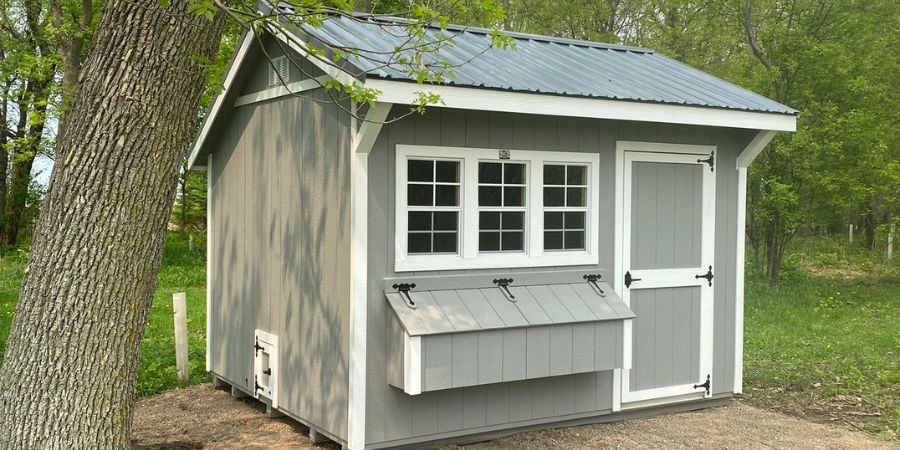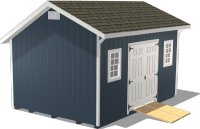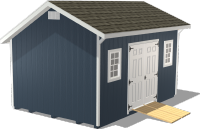Chicken Pen vs. Chicken Coop: What’s Better for Raising Chickens?
by Dakota Storage Buildings, on May 29, 2024

Raising backyard chickens can be a rewarding experience, regardless of your age or occupation. Chickens can bring a multitude of benefits to your daily routine, from the simple joy of their company to fresh eggs for your breakfast table. However, if you are new to the world of chicken keeping, navigating the terminology used to describe where they live can be confusing. You are committed to providing the best care for your chickens, but with terms like "coop," "run," “pen,” and "free range" floating around, how do you determine the most suitable living arrangement for them? Understanding the nuances of chicken coops is crucial to ensuring their health, happiness, and productivity.
What’s the Difference Between a Chicken House and a Chicken Pen?
First of all, let’s clear up the difference between a chicken pen and a free range chicken coop. Once we have these two things defined, it will be much easier for you to make a decision regarding which one is best for your situation. Depending on who you talk to, a chicken “coop” can mean either just the building in which your chicken's nest or the building and the fenced-in area around it. This fenced-in area is often referred to as a “run” or a “pen”, and generally speaking, most chicken owners believe the coop and the pen to be two separate things.
Chicken House vs Pen: The Pros and Cons of Each
Exploring the benefits and considerations of free range chicken coops and pens can help you make an informed decision on the best housing for your flock.
Benefits of a Chicken Coop:
- Versatile Design: A chicken house is generally comprised of two main parts: a sheltered house for nesting and sleeping and an attached caged area for safe outdoor access. This design caters to the chickens' need for security and their instinct to roam outdoors.
- Aesthetic Appeal: Coops are available in various shapes, with rectangular and triangular being the most common. Rectangular coops, in particular, offer more protected outdoor space. These options ensure chicken coops can be both visually pleasing and functional.
- Ease of Access and Maintenance: Many coops are designed for easy access, making daily chores like feeding and egg collection simpler. Some models even feature a basement area for waste collection, streamlining the cleaning process.
- Customization: Your free range chicken coop can be customized to suit your taste, from a basic setup to more elaborate designs.
Chicken Coop Disadvantages:
- Installation Effort: Installing a chicken coop yourself can require significant effort, especially if installing a base rather than placing it directly on the ground.
- Land Degradation: Over time, the ground beneath the coop can become compacted and barren, which may require periodic relocation to rejuvenate the land.
- Health Risks: Without regular cleaning, coops can harbor bacteria and diseases, posing a risk to your chickens' health. Proper maintenance is essential to keep these risks at bay.
Benefits of a Chicken Pen:
- Safe Outdoor Access: A chicken pen, or run, provides a secure outdoor environment for chickens to exercise and explore, safeguarding them from predators. It functions similarly to how a backyard serves a house, offering space for activities beyond the confines of the coop.
- Enhanced Chicken Well-Being: By allowing chickens to roam, peck, and enjoy fresh air, chicken pens contribute to the physical and mental health of your flock.
- Ease of Construction: Constructing a large chicken pen is generally easier and less time-consuming than a coop. For those seeking convenience, ready-made pens are available that can quickly adapt to your backyard setup.
- Maintenance: Regular cleaning, though necessary, is less intensive than in a coop. A monthly clean-up can help maintain hygiene and prevent diseases.
Chicken Pen Disadvantages:
- Vulnerability to Predators: While pens are designed to be secure, they might not offer the same level of protection as a fully enclosed coop, especially from digging predators or those that can breach fences.
- Exposure to Elements: Chickens in a pen are more exposed to weather conditions. They may be left exposed during extreme weather without adequate shelter within the pen.
- Requires Regular Cleaning: To prevent disease and maintain hygiene, large chicken pens need to be cleaned regularly, at least once a month. Neglect can lead to health risks similar to those found with poorly maintained coops.
Must-Have Features in a Quality Chicken Coop
.jpg?width=900&height=450&name=Blog_Inside%20Chicken%20Coop_900x450%20(1).jpg)
Selecting or constructing a quality free range chicken house is pivotal for nurturing a happy and healthy flock. It requires thoughtful consideration of several key features to ensure it meets all your chickens' needs.
Nesting Boxes
Nesting boxes are essential for egg production and should be spacious, comfortable, and dark enough to provide privacy. An ideal ratio is one box for every 3-4 hens. Strategic placement of these boxes within the coop can prevent egg eating and encourage hens to lay in designated areas.
Airflow and Ventilation
Good air circulation is vital to eliminate moisture, ammonia, and dust, which are harmful to chickens' respiratory systems. However, drafts must be avoided. Proper ventilation, achieved through strategically placed vents or windows, ensures a healthy environment by balancing fresh air intake and stale air expulsion.
Insulation
Adequate insulation plays a dual role: it keeps the interior warm during cold weather and cool in the heat, making the coop habitable year-round. Materials and coop designs that prevent drafts while allowing moisture to escape are key to avoiding damp conditions that could lead to health issues.
Perches
Chickens have a natural instinct to roost off the ground at night for safety and comfort. Providing sufficient perching space allows for this behavior, reduces stress, and prevents pecking order disputes. The perches should be positioned higher than the nesting boxes to discourage roosting where they lay eggs.
High-Quality Materials
The coop’s durability directly impacts the safety and comfort of your chickens. Using high-quality, weather-resistant materials and secure construction methods protects against predators and extreme weather conditions. Hardware cloth is preferred over chicken wire for its superior strength and protection.
Essential Features of a Chicken Pen

The chicken pen, often referred to as the run, acts as the outdoor playground for your flock. When designing or selecting a pen, it is important to prioritize features that promote the well-being and safety of your chickens.
Room to Roam
The importance of ample space cannot be overstressed. Chickens are happier and healthier when they have plenty of room to roam, peck, and scratch. This not only supports their physical health by allowing for exercise but also contributes to a lower-stress environment, reducing the likelihood of feather pecking and aggression. A general guideline is to provide as much space as possible, but at a minimum, each chicken should have access to 8 square feet of run area.
Mobility for Enhanced Flexibility
A movable or mobile chicken pen can be an invaluable feature for those looking to manage their backyard space effectively. Mobile pens can be relocated around your garden or yard, providing your chickens with fresh areas to forage while simultaneously fertilizing different sections of your lawn. This not only enriches the diet of your chickens with natural insects and vegetation but also helps prevent the overuse and degradation of any single area of your outdoor space.
Security Measures to Protect Your Flock
Predators are a constant threat to backyard chickens, and the pen is your first line of defense. A secure chicken pen is constructed with durability in mind, using predator-proof materials such as hardware cloth instead of standard chicken wire. The pen should be fortified against digging predators with buried fencing or a solid base. The top should be covered to protect against aerial threats like hawks and owls. All entry points, including gates or access doors, must have secure fastenings that cannot be easily tampered with by clever predators.
Sizing Matters for Happy and Healthy Chickens
Sizing is a critical aspect when it comes to providing an ideal living environment for chickens. Striking the perfect balance between too much and too little space is key to fostering happy, healthy chickens. Here's a deeper dive into why sizing matters and how to get it right.
Calculating Sizing
When you calculate the sizing for your chicken house, the general rule of thumb is to provide at least 2 to 4 square feet of space per chicken if they are going to be primarily free range but will still use the coop for nesting and nighttime protection. For those chickens confined to a coop and run, ensuring ample space becomes even more crucial to prevent overcrowding and promote a healthy environment.

The Risks of Undersizing Coops
An undersized coop is not just a matter of discomfort for chickens; it can have serious repercussions on their well-being. Chickens living in cramped conditions are more prone to stress, which can manifest in a range of behavioral issues, including pecking and aggression towards each other. This stress can also compromise their immune system, making them more susceptible to diseases. Insufficient space can impede their natural behaviors, such as foraging, preening, and stretching their wings, leading to frustrated and unhappy chickens.
The Surprising Challenges of Too Much Space
The concern with oversized coops is primarily related to the chickens' ability to maintain body warmth, especially during colder months. Chickens rely on their body heat to keep warm, and in a coop that is too large for the number of chickens it houses, they may struggle to stay warm. However, this issue is generally less significant than the problems associated with undersized coops. Providing adequate bedding and ensuring the coop is well-insulated can mitigate these concerns. Having a bit of extra space can be beneficial as your flock grows or if you decide to add more chickens down the line.
Find the Perfect Balance for Your Flock

Finding the perfect balance for your flock’s home is about more than just adhering to space recommendations. It involves understanding and anticipating the needs of your chickens, considering the climate in your area, and planning for future expansions of your flock. This careful consideration ensures that your chickens have a comfortable, safe, and stimulating environment where they can thrive. Choosing the right free range chicken house or chicken pens for sale is about understanding your flock’s needs and your space. Consider starting with the essentials and gradually upgrade or expand as you learn more about your chickens' habits and preferences. Remember, a happy chicken is a productive chicken, and the key to their happiness lies in the quality and suitability of their living environment.
For those ready to find the ideal home for their flock, our guide, “Evaluating the Best-Fit Chicken Coops,” is an invaluable resource. It is designed to help you navigate the choices, ensuring you select a coop and pen that not only fits your space but also enriches the lives of your chickens. Download our guide today and take the first step towards creating a thriving backyard for your feathered friends.

























